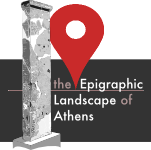Updates #5: Inscriptions from the southwest corner of the Agora: poletai accounts and prytany inscriptions
by Irene Berti
Collecting all the inscriptions and the fragments of inscriptions found in the Southwest corner of the Agora, two categories of documents stand out for the high concentration of finding spots in this area: the poletai accounts and the prytany inscriptions. While the first category is a fourth century phenomenon, the second has a very long story.
The poletai accounts, written usually on very simple stelai, had no publication clause, but the extraordinary concentration of the fragments in the area around the Tholos-Bouleuterion suggests that they were set up there, in an area which was reserved for them and which formed a sort of open-air archive. The results of the investigation of the poletai inscriptions argue in favor of the idea that the Poleterion is indeed to be located in the southwest area of the Agora, and that documentary stelai such as financial accounts usually stood, for practical reasons, in proximity of the related offices.
At least after 307, the honorary inscriptions for the prytaneis were also published in this area (as the preserved publication clauses show), by the Tholos or in front of the Bouleuterion. In this lucky case, the majority of the fragments were found – reused – quite close to the place where they, according to the publication clause, were erected. Since some of the stelai were reused just few years after they were set up, one can argue that they usually did not stood forever, but that after a certain time one systematically made place for new monuments.
Quite different is the situation if we look back to the early prytany inscriptions (between the end of the fifth and the second half of the fourth century BC), which were not honorary but votive monuments, were usually not stelai but inscribed bases supporting statues or reliefs and were probably set up in the tribal shrines. The few fragments in which the dedication to the hero is preserved confirm this suggestion; on the other side, the fact that the majority of dedicators did not feel the need to specify who the receiver of the dedication was, seems to imply that this was obvious. Because in some cases the phyletic sanctuaries were not on a central spot like the Acropolis (where the Kekropis, Pandionis and Erechtheis had their shrines), but in suburban locations (the Hippothontis on the way to Eleusis, for instance) it quickly became customary to dedicate these monuments in front of the monument of the Eponymous Heroes, where visibility and centrality were guaranteed. When, after the end of the fourth century BC, they finally changed from votive offerings into honorary stelai financed by the central authority, they stood close to the area where the prytaneis “went to work”.
To re-locate the early prytany inscriptions is a difficult and laborious task, because the finding spots are either not telling or misleading: some of the best preserved inscribed blocks, reused as architectonic stones, were found scattered away and the evidence shows that this kind of stones could travel a long way from the original place. Nevertheless, combining the analysis of the archaeological documentation with other historical criteria (considering the evidences in the light of the contemporary political communication or religious praxis) it is possible to make some suggestions: although the results can only be, due to the lack of evidence, somewhat provisional, they will hopefully open a debate on a subject which has till now gained little attention or it has been considered an impossible task.Irene Berti (Heidelberg)
Published on: 21 Nov 2018 by Chiara Lasagni



